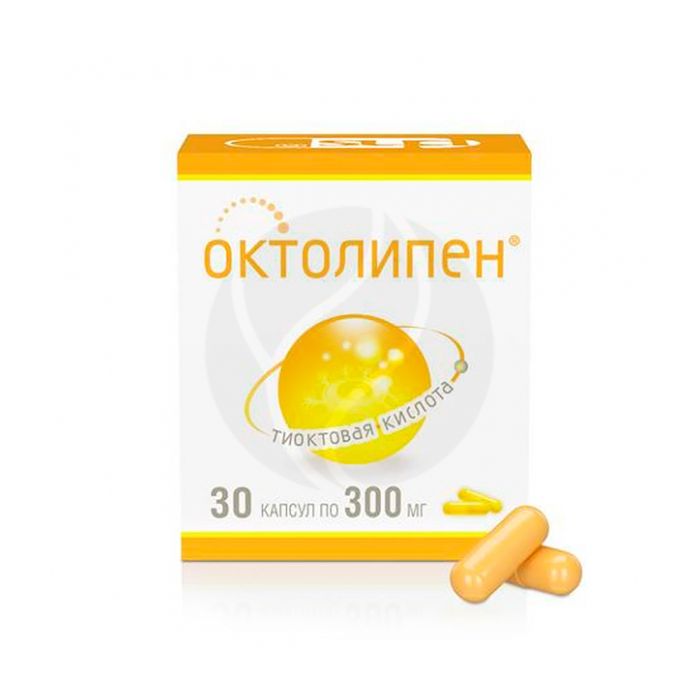Octolipen capsules 300mg, No. 30
Russian Pharmacy name:
Октолипен капсулы 300мг, №30
Diabetic polyneuropathy;
alcoholic polyneuropathy.
Inside, on an empty stomach, 30 minutes before meals, without chewing, drinking plenty of fluids.
1 tab. / 2 caps. (With 600 mg) once a day. It is possible to carry out stepwise therapy: taking the tablets is started after a 2Ц4-week course of parenteral administration of thioctic acid. The maximum course of taking pills is 3 months. In some cases, taking the drug involves a longer use, the timing of which is determined by the doctor.
Hard gelatin capsules, size No. 0, opaque, yellow; the contents of the capsules are light yellow or yellow powder; blotches of white are allowed.
1 caps.
thioctic (?-lipoic) acid 300 mg
Excipients: calcium hydrogen phosphate (disubstituted calcium phosphate) - 23.7 mg, pregelatinized starch - 21 mg, colloidal silicon dioxide (aerosil) - 1.8 mg, magnesium stearate - 3.5 mg, hard gelatin capsules - 97 mg [titanium dioxide (E171) - 2.667 %, quinoline yellow (E104) - 1.839%, sunset yellow dye (E110) - 0.0088%, medical gelatin - up to 100%].
Hypersensitivity (to thioctic acid and drug components);
pregnancy;
the period of breastfeeding (there is no sufficient experience with the use of the drug);
children under 18 years of age (efficacy and safety have not been established).
pharmachologic effect
Thioctic acid (?-lipoic acid) is found in the human body, where it acts as a coenzyme in the reactions of oxidative phosphorylation of pyruvic acid and alpha-keto acids. Thioctic acid is an endogenous antioxidant. Thioctic acid helps to protect cells from the toxic effects of free radicals arising in metabolic processes, neutralizes exogenous toxic compounds. Thioctic acid increases the concentration of the endogenous antioxidant glutathione, which leads to a decrease in the severity of symptoms of polyneuropathy.
The drug has a hepatoprotective, hypolipidemic, hypocholesterolemic, hypoglycemic effect; improves the trophism of neurons. The result of the synergistic action of thioctic acid and insulin is an increase in glucose utilization.
Pharmacokinetics
Absorption and distribution
When taken orally, the drug is rapidly and completely absorbed from the gastrointestinal tract; simultaneous administration with food can reduce the absorption of the drug. Taking the drug, according to the recommendations, 30 minutes before meals, avoids unwanted interactions with food, because the absorption of thioctic acid at the time of the meal has already been completed. Cmax of thioctic acid in blood plasma is reached 30 minutes after taking the drug and is 4 ?g / ml. The absolute bioavailability of thioctic acid is 20%.
Metabolism and excretion
Thioctic acid has a 'first pass' effect through the liver. The main metabolic pathways are oxidation and conjugation. Thioctic acid and its metabolites are excreted by the kidneys (80-90%). T1 / 2 - 25 min.
Side effect
From the gastrointestinal tract: often - nausea; very rarely - vomiting, pain in the stomach and intestines, diarrhea, change in taste.
Allergic reactions: very rarely - skin rash, urticaria, itching, anaphylactic shock.
From the nervous system: often - dizziness.
General reactions: very rarely - due to improved glucose utilization, blood glucose levels may decrease and symptoms of hypoglycemia (confusion, increased sweating, headache, visual disturbances) may appear.
Application during pregnancy and lactation
The use of the drug during pregnancy is contraindicated due to the lack of sufficient clinical experience with the use of thioctic acid during pregnancy.
The use of the drug during lactation is contraindicated due to the lack of data on the penetration of thioctic acid into breast milk.
Application in children
The use of the drug in children and adolescents under the age of 18 is contraindicated (efficacy and safety have not been established).
special instructions
When taking OctolipenЃ, you should refrain from drinking alcoholic beverages, since alcohol consumption is a risk factor for the development of polyneuropathy and can reduce the effectiveness of treatment.
Treatment of diabetic polyneuropathy should be carried out while maintaining the optimal concentration of glucose in the blood.
Influence on the ability to drive vehicles and mechanisms
The effect on the ability to drive vehicles and mechanisms has not been specifically studied. Care must be taken when driving vehicles and engaging in potentially hazardous activities that require increased concentration of attention and speed of psychomotor reactions.
Overdose
Symptoms: in the case of taking thioctic (?-lipoic) acid in doses of 10-40 g, there may be serious signs of intoxication (generalized convulsions; severe acid-base balance disorders leading to lactic acidosis; hyperglycemia, up to hypoglycemic coma; severe blood clotting disorders, sometimes leading to a fatal outcome). If a significant overdose of the drug is suspected (doses equivalent to more than 20 capsules for an adult or more than 50 mg of thioctic acid per kg of body weight for a child), immediate hospitalization of the patient is necessary.
Treatment: there is no specific antidote. Symptomatic treatment, if necessary - anticonvulsant therapy, measures to maintain the functions of vital organs.
Drug interactions
With the simultaneous appointment of thioctic acid and cisplatin, a decrease in the effectiveness of cisplatin is noted.
Thioctic acid binds metals, so it should not be administered concurrently with drugs containing metals (for example, iron, magnesium, calcium). According to the recommended route of administration, OctolipenЃ is taken 30 minutes before breakfast, while drugs containing metals should be taken at lunchtime or in the evening. For the same reason, during the treatment period, it is recommended to consume dairy products only in the afternoon.
With the simultaneous use of thioctic acid and insulin or oral hypoglycemic drugs, their effect may be enhanced, therefore, regular monitoring of blood glucose levels is recommended, especially at the beginning of thioctic acid therapy.
In some cases, it is permissible to reduce the dose of hypoglycemic drugs in order to avoid the development of symptoms of hypoglycemia.
Ethanol and its metabolites weaken the effect of thioctic acid.

